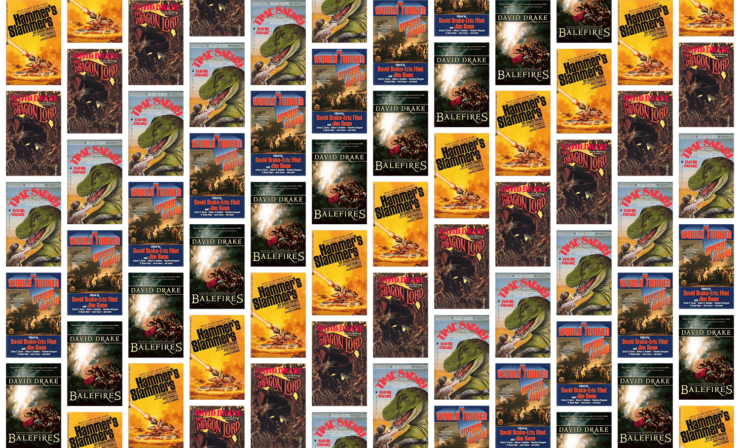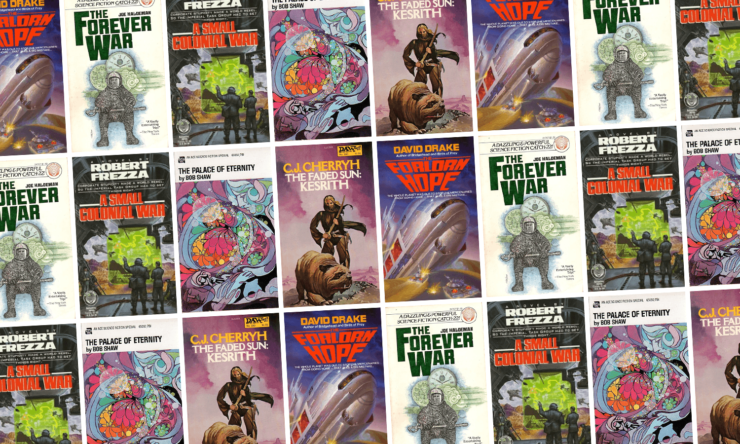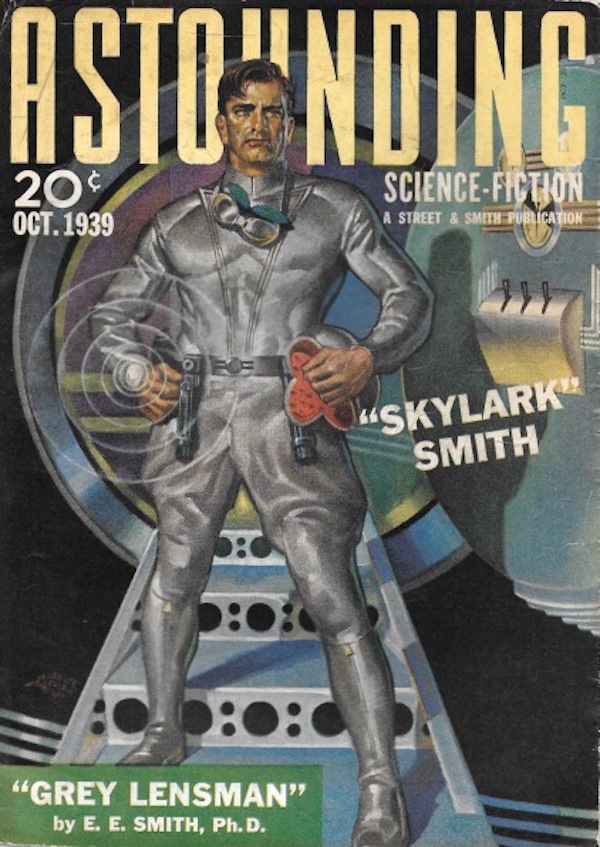In this bi-weekly series reviewing classic science fiction and fantasy books, Alan Brown looks at the front lines and frontiers of the field; books about soldiers and spacers, scientists and engineers, explorers and adventurers. Stories full of what Shakespeare used to refer to as “alarums and excursions”: battles, chases, clashes, and the stuff of excitement.
When reading obituaries after David Drake’s recent death, I noticed one of his books I hadn’t read before being mentioned by a number of people as one of his best. That novel is Redliners, and I decided to seek it out. I’m glad I did, because the book is indeed one of his best. And among Drake’s always gripping depictions of the horrors of war, it offers something that had not been present in his earlier works: a sense of hope and redemption.
Like many science fiction and fantasy fans, I was saddened to hear about David Drake’s passing. I had read many of his books, although since his output included over 40 solo novels, and at least that many more collaborations and short story anthologies, I doubt there are many who can say they’ve read everything he wrote (near as I can tell, I’ve read about a third). But late in the 1980s and on into the 1990s, during Drake’s most prolific years, I was going to school in the evenings, busy with service as a reserve officer, and began reading less in general (and significantly less science fiction). So, I missed much of Drake’s later work. I’ve caught up on a few of those books since then, and after finding a treasure like Redliners, I expect I will be reading more in the future.
About the Author
David Drake (1945-2023) was an American writer of science fiction and fantasy whose career began in the 1970s and ended when he retired from writing due to health issues in 2021. You can see an obituary of Drake here, and also a column by James Davis Nicoll that discusses five seminal books from Drake’s career. He was known especially for tales, whether science fiction or fantasy, which gave the reader a stark and unflinching view of warfare.
I’ve looked at David Drake’s work before in this column, reviewing The Forlorn Hope, an early military adventure novel; The Forge, his first collaboration with S.M. Stirling in the General series; Hammer’s Slammers, the first collection in a series that grew to about seven to ten books’ worth of short stories, novelettes, and novels; and “Contact!”, a short story included in the collection Body Armor: 2000 (because of Drake’s popularity, there weren’t many military science fiction collections from the end of the 20th century that didn’t include one of his stories). Those earlier columns also included biographical information, and references to his other work.
Several of Drake’s books are available to download free of charge from the Baen Books Free Library.
The Costs of Service
Drake’s military books, especially the earliest ones, focused on the horrors of war, and were shaped by his service in America’s failed involvement in the long, brutal war to determine the post-colonial fate of Vietnam. Like many veterans of that war, Drake was traumatized by the experience, and he was often quoted as saying about his Hammer’s Slammers series, “The stories…were more important to me as self-therapy than they were as the start of a career.” The stories he wrote were brutal, and the fear and anger of the protagonists were palpable. But as his career progressed, you could see that Drake was coming to terms with his experience, and the tone of his stories began to moderate.
I didn’t read Redliners when it first came out in 1996, but now that I have, I can see the book was a turning point not only in Drake’s career, but in his efforts to come to terms with his wartime experience. The book is still as blunt and violent as his earlier work, but there is an additional element in the book, a thematic strain of hope and reconciliation.
Drake himself stated on his website:
Redliners is possibly the best thing I’ve written. It’s certainly the most important thing, both to me personally and to the audience I particularly care about: the veterans, the people who’ve been there, wherever ‘there’ happened to be. Having said that, Redliners isn’t a book for everybody. It’s very tough even by my standards, and to understand the novel’s underlying optimism you have to have been some very bad places.
Soldiers in Vietnam fought in miserable conditions, waging a conflict whose goals were ambiguous at best. And when they came home, they learned from sources like the Pentagon Papers that the war had been lost years before the fighting ended. I did not serve in Vietnam, but I served during the Vietnam era, and remember being spat at and called a “baby killer” a few times in public, simply because I wore a uniform. Those were not days when veterans were greeted with a “thank you for your service.” Returning soldiers were denied peace even after the conflict ended.
In Redliners, Drake looks at that other side of war, and raises some interesting questions. What might happen if veterans were given a more noble task than killing the enemy, and offered gratitude instead of scorn? What might happen if the people they protected were able to see and appreciate their suffering? What might happen if their leaders treated them as people, and not just as resources to be expended on the battlefield?
Redliners
The book starts not on the battlefield, but with a first-person prologue from a man who calls himself John Smith, the Chief of Administration of the Unity, a government that leads all of humanity. He speaks about the ongoing war with a humanoid species that calls themselves the Kalendru. Like many senior civil servants, he has a computer grafted into his nervous system. His powers are dictatorial, and he describes himself as ruthless and merciless. He worries that he is nearing a time when he is losing his edge, and must retire.
We then join an advance party for Operation Active Cloak, the “strikers” of Strike Force Company C41, leading an invasion of a Kalendru world, commanded by Major Arthur Farrell, and dropped into action in a captured enemy starship. Drake uses the action to introduce the members of that unit, which had been on the sharp end of many such actions (probably too many such actions). Drake also, without clogging the narrative with too much exposition, introduces us to the weapons used by the strikers and their enemies, including their ranges and capabilities, displaying his usual meticulous attention to detail. The action is brutal, and some of the strikers die soon after we meet them. Almost as soon as the unit lands, an enemy task force is detected inbound, and C41 is ordered to retreat to a retrieval craft (which may or may not arrive).
In addition to the Major, two characters stood out for me; heavy weapons unit member Esther Meyer, and scout Caius Blohm. Meyer ends up one of the only survivors when her comrades are obliterated by an enemy missile. Blohm incinerates the occupants of an enemy barracks only to be horrified when he finds the building was full of non-combatants—women and children. The unit suffers grievous losses in their retreat, which would have been even worse had Meyer not taken out an enemy tank single-handed.
We then get another interlude where Mr. Smith takes a personal interest in the fate of the troops involved in Active Cloak, explaining to his aide, Ms. Chung, how difficult it is to re-integrate combat troops back into society. We then cut to the garrison world of Stalleybrass where C41 veterans are refused entry into a military bar because they are in combat attire, and return with an armored car and weapons to shoot the place up and steal some beer, proving Mr. Smith’s point about returning troops. Mr. Smith and Ms. Chung then discuss how not just the individuals in C41, but the entire unit has been redlined—a designation which means they are no longer considered capable of serving reliably. But Smith has a plan for the unit, which does not involve standing them down.
C41 then receives orders to deploy again, and they grimly comply, despite not having had time to recover from their last action. They improbably find themselves on Earth, not at a military starport, but at an Emigration Port. Their mission will be to accompany a colonization team to a new world, acting as their security element, and protecting them from hostile flora and fauna as they establish a base. The unit is in tatters, with only a couple of officers left, and only a couple of heavy weapons troops remaining. They meet the project manager, Jafar al-Ibrahimi, and his aide, Tamara Lundie. The colonists are involuntary, the occupants of a middle-class apartment complex, Chicago’s Horizon Towers, who have been ordered to leave their homes and travel to another world (the Unity, as Mr. Smith mused in the prologue, is indeed ruthless in doing what has been determined as being in the best interest of humanity as a whole).
In a positive sign, members of the unit step in to protect the colonists as they are being abused by local police, and Farrell, unused to compliments, is stunned when al-Ibrahimi commends the strikers’ actions. But striking a more ominous note, Striker Blohm becomes twitchy upon seeing that so many of the colonists are children, just like those he accidentally murdered during Operation Active Cloak. And in an even more ominous development, during their outbound flight the strikers learn that the ecology of their destination is extremely dangerous; in fact, outright hostile.
The team’s mission goes wrong as soon as they land. Instead of the magnetic landing grid their automated craft had been intended to land on, the ship has homed in on an iron-rich asteroid of the type used to guide enemy Kalendru warships into their destinations. They find enemy dead, killed by lethal plants. And the landing site is in a large circular lowland, surrounded by dense forests, and filled with the deadliest of the planet’s many threats. Their ship is severely damaged, and they must recover as much equipment as they can. They have an aircar, and attempt to scout the path between themselves and the intended landing site, but bacteria clogs the fans and it crashes. The team has two large earth-moving tractors that can tow the gear that the colonists and strikers need, but the colonists refuse to part with their personal belongings until it becomes inescapably clear that these must be left behind. The deaths begin before their journey is even underway, as both strikers and colonists succumb to the perils of the wilderness.
Caius Blohm’s skills as a scout are invaluable, as he is one of the only strikers who can move through the wilderness without triggering deadly responses. He is equipped with a converter that can take local vegetation and turn it into edible food, but he refuses to surrender it as he might need it during his scouting expeditions. Instead, he is tasked, when in camp, to use the converter to feed others, and is assigned to a widowed woman who cares for children already orphaned. Blohm finds comfort in protecting the children, especially a little girl, Mirica. Esther Meyer, because of her armor and heavy weapons, is assigned to one of the bulldozers to fight off threats that cannot be flattened by its earthmoving blade. She in turn finds some peace in the arms of a colonist who has lost his wife. Jafar al-Ibrahimi and Tamara Lundie prove to be able leaders, deferring to the Major and his strikers on matters of security—but it also becomes obvious that they have computer enhancements, and are far from ordinary leaders for a typical colonization effort.
As the party makes their way toward their intended landing site, the planet’s attacks grow fiercer. Soon they are facing primitive humanoids that, while individually not very capable, fight as if they are guided by one mind. They encounter more Kalendru survivors, and become convinced the only way to save themselves is to discover the secret of this horrifying lowland, an answer that can only be found at its center. Their only slim chance of salvation is to travel to the depths of hell itself.
Final Thoughts
Redliners is indeed one of Drake’s finest novels. While I found some of his earlier books a bit too grim, this one offers, along with a compelling depiction of the horrors of war, a sense that if veterans are treated humanely, and given tasks that are meaningful, even the most damaged among them can find at least some measure of peace. The ending is more compelling emotionally than logically (I still don’t see the sense in sending a random cross section of humanity to a hostile colony world), but I found it very satisfying.
And now that you’ve listened to my thoughts, I’d like to hear yours, whether you’ve read Redliners yourself, or just want to comment on your favorite military science fiction stories in general.














